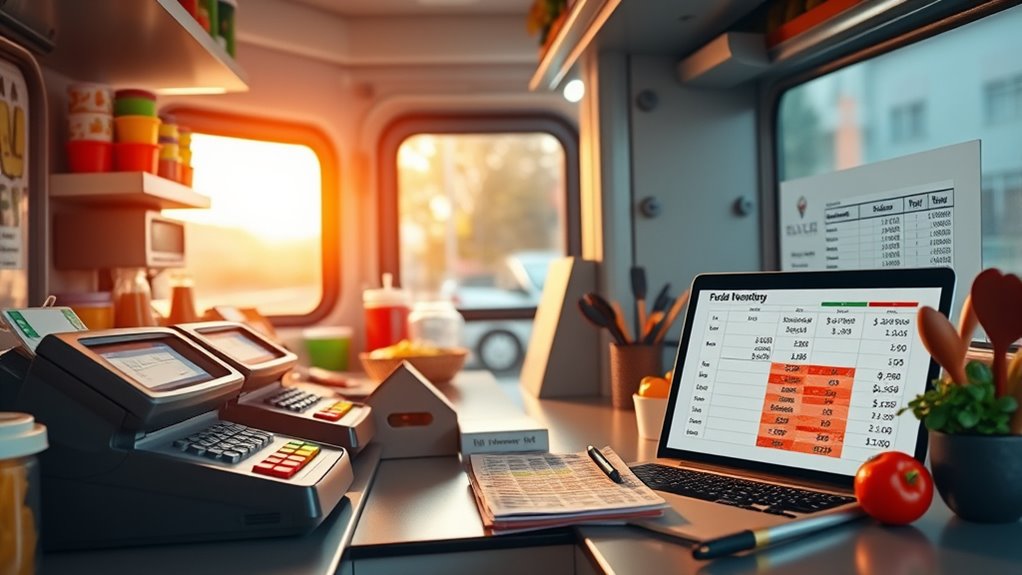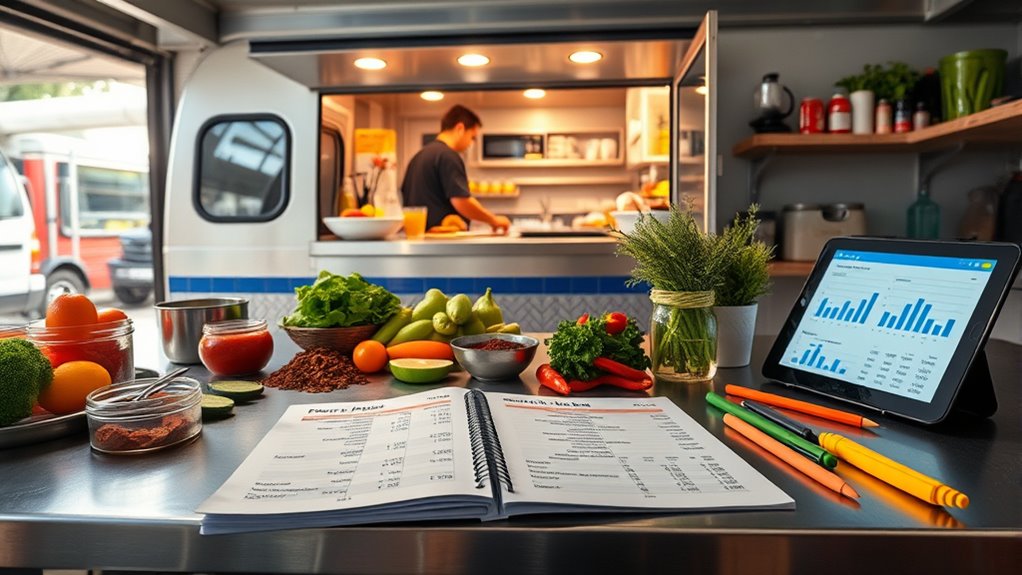To guarantee your food truck’s success, you need a solid budget that covers startup costs like menu design and staff hiring, plus ongoing expenses such as supplies, maintenance, and marketing. Track your cash flow closely, set aside an emergency fund, and update your budget regularly as sales and costs fluctuate. Smart budgeting helps you stay profitable and prepared for unexpected expenses. Keep exploring these strategies to master your food truck finances.
Key Takeaways
- Accurately estimate startup costs, including equipment, menu design, and staff hiring, to establish a realistic initial budget.
- Track recurring expenses like ingredients, supplies, and maintenance to set sustainable menu pricing.
- Allocate funds for ongoing marketing efforts, both digital and print, to increase visibility and customer engagement.
- Maintain an emergency fund for unexpected costs such as ingredient price hikes, repairs, or staffing issues.
- Use detailed sales and expense tracking to adjust budgets proactively and ensure consistent profitability.
Estimating Startup Costs for Your Food Truck

Estimating your startup costs is a crucial first step in launching a successful food truck. One of the key expenses is menu design, which influences your equipment needs and food costs. A well-crafted menu can reduce waste and streamline operations, saving you money upfront. Staffing costs are another major component; consider how many employees you’ll need initially and their wages. These costs include wages, benefits, and training. Don’t forget to factor in the costs for creating an appealing menu and hiring staff before you hit the road. Additionally, understanding design elements that appeal to your target audience can help optimize your menu layout and presentation, further enhancing efficiency. Accurately estimating these expenses helps you set a realistic budget and prevents surprises down the line. Planning carefully now ensures you’ll have the resources to execute your menu and staff your truck effectively when you start serving customers.
Planning for Operating Expenses and Supplies

Have you considered the ongoing expenses required to keep your food truck running smoothly? Planning for operating expenses involves more than just initial costs. You need to budget for ingredient sourcing to guarantee quality and consistency, which can fluctuate based on season and supplier prices. Staff wages are another significant expense; fair pay attracts reliable employees and keeps morale high. Additionally, supplies like cleaning products, paper goods, and utensils add up quickly. It’s vital to track these recurring costs carefully so you can price your menu appropriately and maintain profitability. Regularly reviewing your expenses helps you identify areas where you can optimize spending without sacrificing quality. Staying on top of these ongoing costs is fundamental for the stability and growth of your food truck business. Implementing cost-saving strategies can further enhance your financial management.
Budgeting for Maintenance and Repairs

To keep your food truck running smoothly, you need to budget for regular inspections and maintenance. Setting aside an emergency repair fund guarantees you’re prepared for unexpected issues. Implementing preventive strategies helps reduce costly repairs and keeps your truck on the road. Regularly consulting industry trends can also help anticipate potential problems and stay ahead of maintenance needs.
Regular Inspection Scheduling
Scheduling regular inspections is essential to keep your food truck running smoothly and to prevent costly breakdowns. Consistent checks ensure you stay ahead of potential issues and meet health inspections. Follow a clear cleaning schedule to maintain sanitation standards, avoiding fines or shutdowns. To optimize your inspection routine, consider these key points: 1. Schedule inspections at regular intervals, such as monthly or quarterly. 2. Keep detailed records of maintenance and repairs to track recurring issues. 3. Conduct internal health inspections to identify problems before official reviews. 4. Ensure all parts, including refrigeration and cooking equipment, are thoroughly checked. Regular inspections also help in identifying preventative maintenance needs, extending the lifespan of your equipment and reducing long-term costs.
Emergency Repair Fund
Setting aside an emergency repair fund is a crucial step in ensuring your food truck remains operational during unexpected breakdowns. When your vehicle needs urgent repairs, this fund prevents sudden financial strain and keeps your food truck branding intact by avoiding downtime. Unexpected repairs can disrupt menu development, forcing you to compromise quality or service. By allocating a specific amount each month, you create a safety net that covers repairs like engine issues, electrical problems, or mechanical failures. This proactive approach helps you stay focused on growing your business instead of scrambling for cash in emergencies. Remember, regular maintenance minimizes surprises, but an emergency repair fund offers peace of mind and keeps your food truck running smoothly, ensuring your branding and menu development stay on track. Incorporating preventive maintenance into your routine can further reduce the likelihood of unexpected repairs and extend your vehicle’s lifespan.
Preventive Maintenance Strategies
Implementing preventive maintenance strategies is essential for keeping your food truck in top condition and avoiding costly repairs down the line. Regular upkeep helps improve fuel efficiency and ensures safety protocols are met. To maximize effectiveness, consider these steps:
- Schedule routine engine and oil checks to boost fuel efficiency and prevent breakdowns.
- Inspect tires and brakes frequently for safety and performance.
- Clean and calibrate kitchen equipment to maintain hygiene and prevent costly malfunctions.
- Review safety protocols regularly and update training to keep your staff prepared.
- Incorporate regular equipment inspections to identify potential issues early and extend the lifespan of your tools and appliances.
Allocating Funds for Marketing and Promotions

Allocating funds for marketing and promotions is essential to building your food truck’s reputation and attracting steady customers. To maximize impact, invest in social media campaigns that engage your target audience and showcase your menu. Regularly updating platforms like Instagram and Facebook can boost visibility and generate buzz. Additionally, set aside a budget for print advertising such as flyers, posters, or local newspapers to reach community members who may not be active online. Combining digital and traditional marketing methods helps create a well-rounded promotional strategy. Keep track of your expenses and measure the effectiveness of each approach, so you can adjust your spending for the best results. Strategic allocation of marketing funds ensures consistent brand presence and helps grow your customer base over time. Incorporating targeted marketing strategies can further enhance your outreach efforts and improve return on investment.
Managing Cash Flow and Revenue Streams

To keep your food truck profitable, you need to monitor your daily sales closely, so you can spot trends and address issues quickly. It’s also smart to explore different income sources like catering or merchandise to boost revenue. Managing your cash flow effectively guarantees you stay prepared for slow days and unexpected expenses. Incorporating performance upgrades can help improve your operational efficiency and customer satisfaction.
Tracking Daily Sales
Have you ever wondered how tracking your daily sales can make or break your food truck’s cash flow? Monitoring daily sales helps you identify trends and adjust your operations quickly. It also keeps you aligned with your recipe development goals, ensuring popular dishes generate consistent revenue. To maximize effectiveness:
- Record every sale accurately to maintain reliable data.
- Analyze patterns to optimize staff scheduling, reducing waste and overstaffing.
- Track sales by menu item to identify bestsellers and slow movers.
- Use daily data to refine your budgeting, ensuring you allocate funds wisely.
- Understanding sales data is crucial for making informed decisions and staying competitive.
Consistent tracking helps you stay aware of revenue streams and manage cash flow proactively, so your food truck stays profitable and well-prepared for busy days.
Diversifying Income Sources
While focusing on your main menu is essential, relying solely on food sales can limit your revenue potential. To diversify your income sources, consider menu innovation—adding seasonal or specialty items that attract new customers and keep regulars engaged. Partnering with local events or offering catering services can generate additional cash flow. Building customer loyalty through loyalty programs or social media promotions encourages repeat business, stabilizing your revenue stream. You might also explore merchandise sales or branded packaging as supplementary income. Incorporating additional income streams can help you better manage cash flow and reduce dependence on daily foot traffic and weather conditions. By expanding beyond traditional sales, you reduce dependence on daily foot traffic and weather conditions. This approach not only boosts your cash flow but also enhances your brand presence, helping you stay profitable even during slow days.
Setting Aside Funds for Unexpected Expenses

Unexpected expenses can quickly derail your food truck’s success if you’re not prepared. Setting aside funds for surprises guarantees you stay afloat during unexpected costs. For example, ingredient sourcing can fluctuate, leading to sudden price hikes. Staff scheduling mishaps might require extra shifts or replacements. To be ready, consider these tips:
- Allocate a separate emergency fund to cover sudden ingredient price increases.
- Keep a reserve for staffing issues, like last-minute sick days.
- Regularly review your budget to identify potential gaps.
- Set aside a small percentage of daily income for unforeseen expenses.
- Be aware of essential oils for ingredient preservation that can help extend shelf life and reduce waste.
Having this financial cushion allows you to handle surprises without risking your operation’s stability. Proper planning keeps your food truck rolling smoothly, even when unexpected costs pop up.
Tracking and Adjusting Your Budget Over Time

To keep your food truck’s finances on track, tracking and adjusting your budget regularly is essential. You should review your expenses, focusing on inventory management, to identify waste or overstocking that can cut costs. Keep an eye on sales trends to modify your inventory purchases accordingly. Additionally, monitor staff scheduling to ensure you’re not overspending on labor during slow periods or understaffed during busy times. Regularly updating your budget helps you respond to these changes promptly, preventing financial shortfalls. Use sales data and expense reports to refine your projections. By staying proactive, you’ll maintain better control over your expenses, optimize resources, and set realistic goals for growth. Consistent tracking and adjustment keep your food truck financially healthy and adaptable. Recognizing patterns in sales and angel number symbolism can also provide additional insights into growth opportunities and timing for expansion.
Frequently Asked Questions
How Can I Secure Financing for My Food Truck Startup?
To secure financing for your food truck startup, start by creating a solid business plan highlighting your goals and projected income. Gather necessary food truck permits and establish supplier negotiations to demonstrate your preparedness. Approach banks, credit unions, or online lenders with your plan and documentation. Consider alternative funding sources like investors or crowdfunding. Showing your readiness and understanding of permits and supplier relationships boosts your chances of securing the funds you need.
What Are the Best Tools for Tracking Food Truck Expenses?
To keep your food truck running smoothly, find tools that facilitate expense tracking. Use apps like QuickBooks or Square to manage your finances effectively. They help with inventory management and supplier comparison, so you can spot savings and avoid overspending. These tools give you clear insights, making it easier to stay on top of costs and ensure your food truck stays profitable and prepared for every busy day.
How Do Seasonal Changes Affect My Food Truck Budget?
Seasonal changes impact your food truck budget by causing weather fluctuations that affect sales and inventory needs. You’ll need to adjust your seasonal inventory to match demand, which can vary with the seasons. Expect higher costs for ingredients during peak seasons and potential dips during off-peak times. Planning ahead helps you manage these fluctuations, ensuring your budget stays balanced despite changing weather patterns.
What Tax Considerations Should I Plan for in Budgeting?
Imagine your food truck as a bustling engine, but taxes are the hidden gears you must adjust. You need to plan for sales tax collection and remittance, ensuring you stay compliant, and factor in payroll taxes for your staff. Ignoring these can cause costly penalties. So, include these tax considerations in your budget, set aside funds regularly, and consult a tax professional to keep your food truck rolling smoothly and legally.
How Can I Reduce Costs Without Compromising Quality?
To reduce costs without compromising quality, focus on ingredient sourcing by negotiating with suppliers or buying in bulk. You can also customize your menu to feature popular, cost-effective items that appeal to customers. Streamlining your menu helps minimize waste and simplifies prep, saving money. Prioritize quality ingredients within your budget, and consider seasonal or local produce to cut costs while maintaining high standards.
Conclusion
By carefully budgeting and regularly reviewing your finances, you set your food truck up for long-term success. For instance, allocating funds for unexpected repairs prevented a hypothetical owner from shutting down after a breakdown. Staying proactive with your budget guarantees you can handle surprises, cover operating costs, and grow steadily. Remember, consistent tracking and adjustments will keep your food truck profitable and thriving in a competitive market.









